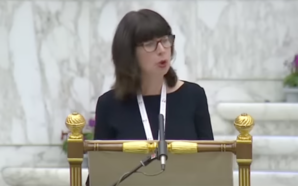Members of the pro-life movement often describe policies that work to undermine the recognition of human dignity and to devalue human life as promoting the “culture of death.” This term was made popular by Pope St. John Paul II in his encyclical Evangelium Vitae, where he used it to describe cultures that malform consciences and promote false ideas of morality by tolerating or supporting sins at the societal level. He wrote:
“It is also a question, in a certain sense, of the ‘moral conscience’ of society: in a way it too is responsible, not only because it tolerates or fosters behaviour contrary to life, but also because it encourages the ‘culture of death’, creating and consolidating actual ‘structures of sin’ which go against life. The moral conscience, both individual and social, is today subjected, also as a result of the penetrating influence of the media, to an extremely serious and mortal danger: that of confusion between good and evil, precisely in relation to the fundamental right to life” (EV 24).
He juxtaposes this term with its opposite, a “culture of life”:
“This situation, with its lights and shadows, ought to make us all fully aware that we are facing an enormous and dramatic clash between good and evil, death and life, the ‘culture of death’ and the ‘culture of life’. We find ourselves not only ‘faced with’ but necessarily ‘in the midst of’ this conflict: we are all involved and we all share in it, with the inescapable responsibility of choosing to be unconditionally pro-life” (EV 28).
Even though Evangelium Vitae touches upon many topics (including the death penalty, ecology, and care for the poor), the document gives particular attention to the evils of abortion and euthanasia. As a result, the “culture of death” came to be associated primarily with these issues in the eyes of many Catholics.
Still, the fact that the pro-life movement has adopted the expression “culture of death,” indicates some consciousness of how a culture of death is usually a symptom of a more prevalent and insidious disease. In other words, culture of death is not a cause, but a consequence of something deeper.
Catholics are particularly sensitive to past papal teachings when they try to diagnose the underlying causes of the culture of death. Sometimes it is ascribed to a “contraceptive mentality,” and Humanae Vitae is praised for being prophetic in this regard. Others will bring up the “dictatorship of relativism,” against which Benedict XVI cautioned.
There is another papal expression, however, that sadly did not penetrate the pro-life lexicon as readily. In fact, most people might not even associate it with the culture of death. I am talking about the concept of “throwaway culture,” something Pope Francis has repeatedly decried. The first time the Holy Father used this expression in a major document was in Evangelii Gaudium:
“Just as the commandment ‘Thou shalt not kill’ sets a clear limit in order to safeguard the value of human life, today we also have to say ‘thou shalt not’ to an economy of exclusion and inequality. Such an economy kills … Human beings are themselves considered consumer goods to be used and then discarded. We have created a ‘throw away’ culture which is now spreading. It is no longer simply about exploitation and oppression, but something new. Exclusion ultimately has to do with what it means to be a part of the society in which we live; those excluded are no longer society’s underside or its fringes or its disenfranchised – they are no longer even a part of it. The excluded are not the ‘exploited’ but the outcast, the ‘leftovers’” (EG 53).
In retrospect, it is easy to understand why “throwaway culture” did not find common acceptance with some Catholics. When Francis said these words, he did so in the context of economic matters, to decry inequality and exclusion. He even goes on to shun “trickle down theories … never confirmed by the facts” (EG 54). On the surface, this expression may not seem to have a direct connection with abortion and euthanasia. In fact, in our current hyper-polarised and hyper-politicised environment, “throwaway culture” was likely associated with social justice causes that many in the pro-life movement tend to associate with their political enemies.
Nevertheless, simple logic tells us that “throwaway culture” is also intrinsically connected to abortion and euthanasia. Is there any other subset of human beings in today’s developed world so prone to be viewed as a “consumer good … to be discarded” as the unborn child? This isn’t just a metaphor. Today, human embryos are produced in labs as commodities and are literally thrown away when they are no longer useful. Euthanasia is also sold to the public as a solution to the expense of caring for the elderly and the infirm, who—like unborn children—are “burdens” on our economy. Many of those who promote abortion and euthanasia seem to say, “Why should we spend so much money on a problem that can easily be done away with?”
We can also argue that “throwaway culture” points to many of the underlying roots of the culture of death that concern Francis’s Catholic critics. For example, artificial contraception makes it easier for a person to use another for sex, and then discard the other person (and the relationship) when it’s convenient. Can’t it be said that a symbol of the throwaway culture is a used condom in a trash can following a one night-stand? And of course this is also a potential cause for abortion, since an arrangement like this cannot sustain a child conceived by accident. Abortion is usually proposed as the easiest solution to that conundrum.
This does raise a question, however. Does Pope Francis himself see these issues as part of the throwaway culture? Does Francis intend for abortion, euthanasia, contraception, and the destruction of human embryos as an extension of the throwaway culture that is most often associated with social injustices and economic inequality? The answer is yes. For example, in Amoris Laetitia, Francis discusses how the “throwaway culture” undermines romantic relationships:
“Here I think, for example, of the speed with which people move from one affective relationship to another. They believe, along the lines of social networks, that love can be connected or disconnected at the whim of the consumer, and the relationship quickly ‘blocked’. I think too of the fears associated with permanent commitment, the obsession with free time, and those relationships that weigh costs and benefits for the sake of remedying loneliness, providing protection, or offering some service. We treat affective relationships the way we treat material objects and the environment: everything is disposable; everyone uses and throws away, takes and breaks, exploits and squeezes to the last drop. Then, goodbye. Narcissism makes people incapable of looking beyond themselves, beyond their own desires and needs” (AL 39).
On euthanasia, Amoris Laetitia also references Francis’s general audience address of March 11, 2015, in which he said this about the elderly:
“The first important thing to stress: it is true that society tends to discard us, but the Lord definitely does not! The Lord never discards us. He calls us to follow Him in every age of life, and old age has a grace and a mission too, a true vocation from the Lord. Old age is a vocation … How I would like a Church that challenges the throw-away culture with the overflowing joy of a new embrace between young and old! This is what I ask of the Lord today, this embrace! … I invite all, especially in this favourable season of Lent, to commit yourselves to building a society in which there is room to welcome each one, most of all when one is elderly, sick, poor and fragile.“
The connection becomes even more clear and straightforward in Francis’s latest encyclical Fratelli Tutti. He opens his section titled “A throwaway world” with the words:
“Some parts of our human family, it appears, can be readily sacrificed for the sake of others considered worthy of a carefree existence. Ultimately, ‘persons are no longer seen as a paramount value to be cared for and respected, especially when they are poor and disabled, ‘not yet useful’ – like the unborn, or ‘no longer needed’ – like the elderly. We have grown indifferent to all kinds of wastefulness, starting with the waste of food, which is deplorable in the extreme.
A decline in the birth-rate, which leads to the aging of the population, together with the relegation of the elderly to a sad and lonely existence, is a subtle way of stating that it is all about us, that our individual concerns are the only thing that matters” (FT 18).
The footnote to passage from Fratelli Tutti references a 2014 address where the connection is made even clearer:
“Unfortunately, what is thrown away is not only food and dispensable objects, but often human beings themselves, who are discarded as ‘unnecessary’. For example, it is frightful even to think there are children, victims of abortion, who will never see the light of day.”
The idea of the throwaway culture did not begin with Pope Francis, however. We can go back to the same document that brought the expression “culture of death” to prominence. John Paul II makes essentially the same point in Evangelium Vitae, when he describes how the culture of death is fostered by cultural elements that see weak, disabled, or otherwise “unproductive” people as burdens to be removed:
“This culture [of death] is actively fostered by powerful cultural, economic and political currents which encourage an idea of society excessively concerned with efficiency. Looking at the situation from this point of view, it is possible to speak in a certain sense of a war of the powerful against the weak: a life which would require greater acceptance, love and care is considered useless, or held to be an intolerable burden, and is therefore rejected in one way or another. A person who, because of illness, handicap or, more simply, just by existing, compromises the well-being or life-style of those who are more favoured tends to be looked upon as an enemy to be resisted or eliminated” (EV 12).
There is seamless continuity between these popes on this matter. And they both saw that the culture of death (or throwaway culture) applies to many issues in addition to abortion and euthanasia. For example, Francis links the throwaway culture to pollution and environmental destruction in Laudato Si’ and to the exploitation of young people in Christus Vivit as well.
And both Francis and John Paul would agree that it is impossible to effectively fight the culture of death while ignoring the throwaway culture pervading our contemporary world. Certainly, sexual immorality and relativism also contribute to this state of affairs. And of course, we can’t ignore our opposition to these evils of our age. But social realities are multifactorial. Multiple causes will typically come into play to strengthen each other to produce the final effect. And this is what has led to the culture of death. Pro-life Catholics must not ignore this.
It is also vital to remember, as John Paul II says in Evangelium Vitae, that the greatest cause of the culture of death is a loss of the sense of God in our day and age. We can rediscover this sense of God by following the Magisterium faithfully and heeding its warnings. “Throwaway culture” has been a consistent theme in Francis’s pontificate, just as “dictatorship of relativism” was for Benedict XVI, and “culture of death” was for John Paul II. Likewise, it is necessary to include the expression “throwaway culture” in our lexicon. We will not succeed in our mission to change the culture of death unless we work to end the throwaway culture.
Pedro Gabriel, MD, is a Catholic layman and physician, born and residing in Portugal. He is a medical oncologist, currently employed in a Portuguese public hospital. A published writer of Catholic novels with a Tolkienite flavour, he is also a parish reader and a former catechist. He seeks to better understand the relationship of God and Man by putting the lens on the frailty of the human condition, be it physical and spiritual. He also wishes to provide a fresh perspective of current Church and World affairs from the point of view of a small western European country, highly secularised but also highly Catholic by tradition.
With thanks to Where Peter Is, where this article originally appeared.








